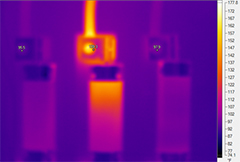

Anyone who has had the opportunity to attend one of our Applications for Infrared Thermography Level 1 courses knows very well the settings in the menu systems that can and cannot be changed. I’ve apologized to my students in the past as I press over and over how important it is to produce good, quality images. Our captured image must be correct, 100% of the time, we cannot just turn on the camera and start shooting.
And for my future students, you too will fully understand what is needed for a good, quality image. The phrases “focus, focus, focus” and “practice makes perfect” are heard most often. Both are critical and are NOT listed in the camera manual. First, focus. In my opinion, this is the most critical setting. The picture cannot be magically re-focused and without good focus the resolution will be poor. So poor that we might not be able to accurately describe what is depicted in the picture. And secondly, the temperature measurement will not be accurate.
For example, I recently had the chance to inspect some electrical equipment in a facility and I decided to capture a couple of images that clearly show what will happen when focus is not used properly.
I took one image of this disconnect that showed a signature that was consistent with a high resistance connection at the wire to lug. From a distance, the signature showed that the energy was highest at the termination and cooled as it traveled down the length of the conductor. But to give a good temperature and the best image, I needed to safely move in closer.

A Gray or any Monochromatic palette is always the best to practice focusing. Using Amber or the “Iron” palette such as in the image above will give good results. The “High Contrast” palettes work well in some applications but is more difficult to focus with. I always recommend, find what works best for you.
Practice makes perfect. When I see a nice crisp edge around the termination lug or the conductor and fuses, I can be confident, and my measurements have a better chance of being accurate. In a sense, we are all telling a story to someone that isn’t there to see it firsthand.

This image above shows the same disconnect, but the focus was slightly manipulated. The temperature of the anomaly appeared to be 180.9F, but the image that is out of focus appears to show the anomaly temperature at 139.3F. And remember, this is just a slight manipulation in focus, worse yet would be a lower temperature that mighy not get reported.
Our cameras have a sensitivity rating. An infrared camera can lose sensitivity due to the person holding it. At the beginning of an inspection, the thermographer should be checking the functionality. The camera must have a calibration check each time used with the correct settings. If not, the data collected will be inaccurate. With proper training, learning what palette works best, and the ability to focus will achieve more reliable temperatures.
Practice makes perfect!